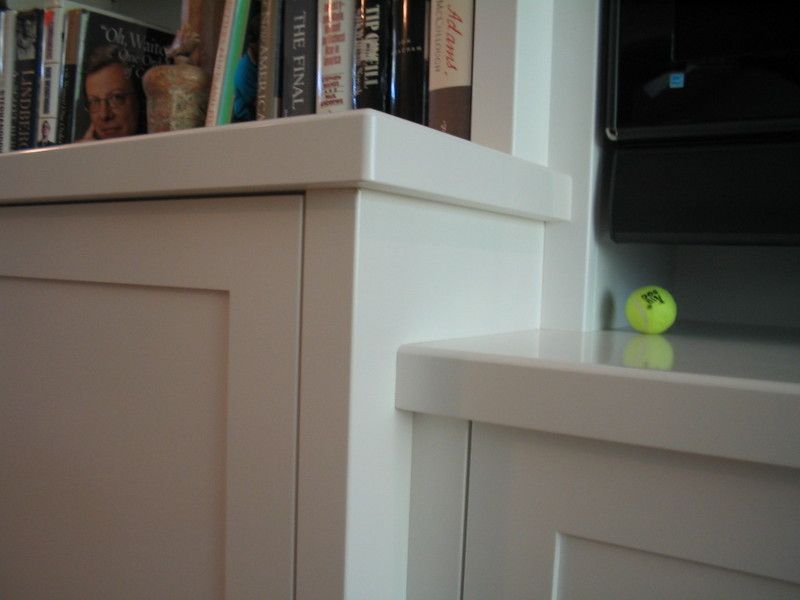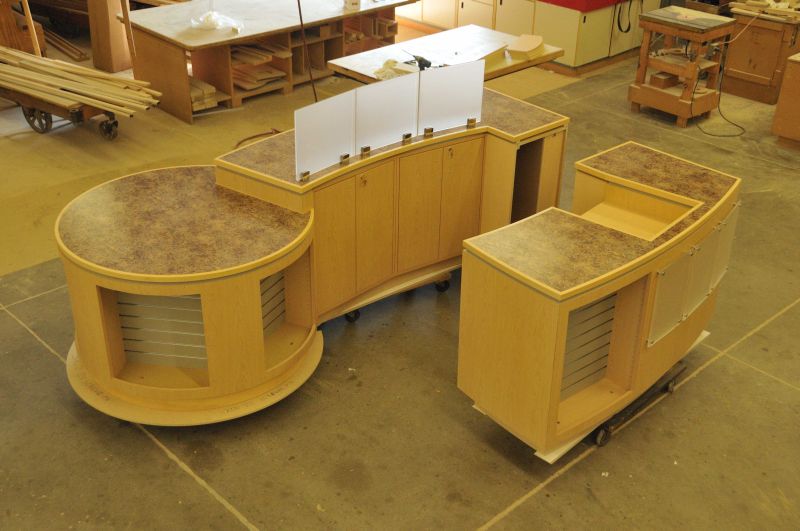Question
I'm a finisher, but also trying to learn cabinetmaking, and enrolling in a college cabinetmaking program for next year. Before I start the program, I'm trying to learn all I can about cabinet construction, but one thing I can't seem to find anywhere is how cabinet boxes are constructed so as not to show any screw heads.
Many of the articles I've read talk about the use of dadoes and rabbets for backs, pocket screws, nailing, etc., but it seems each screw the boxes together. So how are the boxes (end panels) made without showing the screws? Are panels added to the ends after construction, then screwed on from the inside of the box? Are they veneered?
I've watched a couple of videos over where they've used mortise and tenon or biscuits to join boards. Is this how it's done?
Forum Responses
(Cabinetmaking Forum)
From contributor L:
Much has to do with the size of shop and the willingness to invest in the right equipment. Euro boxes can be very efficiently produced using the system developed in, of all places, Europe. That can range from highly automated plants to small shops, but the concepts are the same. Normal practice is to dowel the cases and case clamp them. Been the standard in Europe for 50 years. On this site you will find people that have adapted the system to their level of investment. The tradeoff is labor. I've heard all the arguments to the contrary. But I've got a small shop with the dowel and case clamp system for simple box cabinets. It works really well. There are all sorts of levels you can take it to. It can look traditional or modern. The hardware has been developed for frameless and adapted to face frames, sort of.
By the way, frameless cabinets are not fine woodworking, and any methods you see on the Fine Woodworking sites are overkill for building boxes.
We are talking manufacturing here - business! If your business is manufacturing frameless cabinets, you should look to the best solution for your volume. While probably none of us here have the volume for a fully automated plant, looking for ways to reduce labor content is appropriate. Since our labor is really the only thing any of us have to sell, using less of it for every unit produced makes some sort of sense to me.
A flip-flop boring machine is really the minimum requirement for dowels and confirmats. While I prefer dowels, I don't have a case clamp and use confirmats (with and without dowels) wherever I can.
Applied ends that match the rest of the exterior are needed if you follow the common practice of making the boxes out of a dissimilar material, typically melamine or prefinished plywood. Applied ends are more efficient to build and install (unless you're okay with scribe mold) than finished box ends. Applied ends have no design limitations; they can be edgebanded plywood, door panels, clipped corner assemblies, etc.
I'm a new member of AWI and want to make sure I'm learning all the right habits right from the get-go. It sounds like constructing with dowels is the way to go. Now I just have to tool up for it!
I'm curious why biscuits were never brought up - from much of my reading it seems that biscuit joining was made to replace dowels. Are biscuits an inferior method? I'll look into confirmats as well. Don't know anything about them, but it sounds like I'd still need a line-boring machine for that?
All you need for confirmats is a drill, and a tapered or stepped drill bit. They're very nice in particleboard and MDF. On the very rare occasion I use either of those materials, I'll use confirmats. Drill 'em, screw them together, and move on to the next one. No clamps.
I definitely would not concern myself with assembling boxes with no visible screw holes from the outside. They will always be covered by the adjacent cabinet or an applied end panel.
1. Is a cabinet with only confirmats strong enough for a cabinet that hangs off a wall?
2. How do you apply finished ends? Do you flush the front 3/4" edge with the door of the cabinet? And how do you attach it to the cabinet?
I do some niche commercial cabinets with finished ends, which is why I like dowel construction. But for the basic residential boxes we do, I can see how confirmat might be a better choice given that I don't have a case clamp.
1. Yes!
2. We rarely do applied ends, but follow the designer's drawings when we do. Given a choice I'd flush them with the door fronts. (Full overlay on that door.) We attach them from inside the cabinet with screws.
You can do all sorts of things with applied ends. The example image has two applied ends (one partial) and two matching scribes covering four standard boxes (melamine for the base) and no visible fasteners.


Confirmats are an AWI premium grade fastener, assembly screws are not. The reason is that confirmats are essentially a threaded dowel, whereas assembly screws are thin and allow for more joint movement. The larger diameter and deeper threads of confirmats means that the threads cut in to the denser layers of particleboard that exist towards the outside of the panel, further improving joint strength.
With confirmats, glue is not necessary. This is a big advantage over dowels, biscuits, and Dominoes, in terms of ease of assembly and simplifying rework when it happens.
Biscuits are, in my opinion, a poor choice for corner joint assembly. They penetrate into each joint member only about 1/2". Easy to break if either joint member is flexed much. Dowels or Dominoes are a better choice - just as fast and easy to do as biscuit joints, but stronger.
By using an old Philips screwdriver in adjacent holes, they can be made to perfectly line up just before the final tightening of the first Confirmat.
Confirmats also have the problem of often spreading the core. Keeping them back from the front edge lessens the problem of showing there, but it still exists.
It's sort of true that glue is not necessary, but you will have a better joint if melamine glued.
I've used lots of biscuits and they are perfectly fine for most applications. They are more time consuming.
Bottom line - If you don't feel the need to meet a formal specification and what you are doing meets you and your customer's standards, then stay with it. A doweled case made in a reasonably well setup shop is faster, saves labor and meets standards. The drawback, to get the advantages, is investing in a bore and insert machine and a case clamp.
Dowels and confirmats are equally capable of producing perfectly aligned joints in particleboard. The caveat is that the confirmat pilot holes need to be the same diameter as the confirmat shoulder and thread minor diameter. I don't know how common it is, but all the confirmats I have gotten from Hafele have been undersized on both minor and shoulder diameters (e.g. 3/16" and 6.8 mm). If your machinery/setup cannot produce perfect dowel joints, this is a feature because the difference in diameters allows you to tweak the joint a tad. A bit of glue on the joint will keep tweaked joints from sliding out of position. If your confirmat joints don't line up as well as your dowel joints, the ideal solution would be obtaining bits that allow you to drill proper sized pilot holes. My bet is that matching the minor diameter is all that's needed. An easier solution would be to use a few dowels (glued or not) with the confirmats.